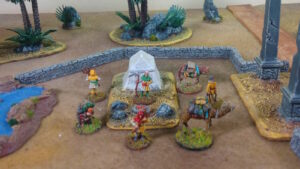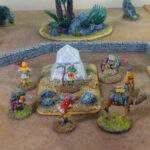 In our last post, we covered the basic mechanics of Four Color Studio’s latest offering, 2d Delves. Today, let’s talk about the campaign game.
In our last post, we covered the basic mechanics of Four Color Studio’s latest offering, 2d Delves. Today, let’s talk about the campaign game.
It’s what the kids these days call “procedurally generated” and “narrative”, meaning that you use random tables and just wave your hands and make up some stuff about what happens between tabletop fights. This is in distinct contrast with author designed, map based campaigns which – theoretically – have better balance.
I’m not so sure about that.
What I am sure about is that games like Nightwatch and Rangers of Shadowdeep relies heavily on authored content to drive its campaigns. Have you ever tried to write a scenario for that game? I have. It’s hard. It’s even hard when somebody else does much of the heavy lifting, and you try to cannibalize content from campaign books written for Frostgrave to build a scenario. Or maybe you just need the right Frostgrave book to tell you how to do that, and I just haven’t come across it yet.
But I digress.
2d Delves offers the expected list of rules that provide some mechanical connective tissue between games. Figures dropped on the table have to roll against a wound chart. Every game you have to pay upkeep costs for each figure (for food and supplies) or roll on a Bad Things Might Happen table. Between each game you roll on a ‘downtime’ table for each figure which could lead to more loot or bad things or even one-shot power-ups to use in your next game.
The principal resource you track for campaign management comes in the form of Quest Points (QP). Get enough of them and you win the game. It’s a simple counter mechanic that works because when you earn QP after a mission, you can choose whether to convert them into Legendary QP or Treasury QP and why Scott Pyle didn’t just use two different names for these is beyond me. I’m going to call them VP and GP, and you can guess which is victory and which is gold. You win the campaign by notching a pre-determined number of VP. A short campaign might only require 10VP to win, and you’ll need eight to ten games to get there because most of your QP will have to be converted into GP to pay that important upkeep cost mentioned earlier.
 Four figures cost 4GP per mission, and you’re probably going to average 5-6 QP per fight. A win might earn you ten, but a bad loss might get you just one or two. If you’re short on cash, you can draw 2VP out of your pool and trade them for a single GP, which makes the decision at game time all the more important.
Four figures cost 4GP per mission, and you’re probably going to average 5-6 QP per fight. A win might earn you ten, but a bad loss might get you just one or two. If you’re short on cash, you can draw 2VP out of your pool and trade them for a single GP, which makes the decision at game time all the more important.
As far as the actual campaigns go? LOL just make something up, bro. Scott gives us a table for randomly generating the name of your quest, and even a nice map for plotting travel. Both of these are pure trips to flavortown, though, because there aren’t any real mechanics to tie them to the campaign or the table. Nice touches, but no real meat to them. On the other hand, Scott does offer a d66 chart with travel events that can help or hinder, in fine Warhammer Quest fashion, and these can have real effects on the tabletop skirmish. This turns the journeying to the mission into a fun little mini-game in its own right.
And what are those missions? Pretty standard fare: stand-up fights, rescue missions (shown here), loot grabs, you know the drill. Roll a d6 against a table, then roll to see which bad guys are there to stop you. It gets more interesting when you add in the Weird Events d66 table. This thing gives you fun challenges like rain and ice to slow down your movement and limit visibility, but also a chance of a positive outcome like hidden treasure or one-scenario buffs. With the use skill checks to resolve these events, and the judicious application of Fate Points to flip the tens and ones digits, you get a little more control over these weird events, which are optional in any case. It’s a fun way to turn those six little scenarios into something special – that simple raid to destroy a Dark Idol in the woods takes on a new menace when the idol is the source of a dead mana zone and your wizard can’t cast any spells until the idol has been reduced to half its hit points.
The real challenge comes with Scott’s insistence on light being so important. Caves are always dark, and you better bring a light source with you to illuminate your immediate surroundings. Outside you have an equal chance of the encounter occurring at night and in the daytime, and a chance that you only get a turn or two of light before darkness falls in the evening or a turn or two of night fighting while waiting for the sun to rise on turn three.
To make matters worse, the enemy is not hampered by the darkness and the game’s AI takes that into account. Monsters will target light sources first, the loss of which penalizes most skill checks made by your team. It can be pretty nasty, but the game is flexible enough to allow for some common sense. In the above photo, for example, the encounter occurs at night. Since there is a fire-pit present, the player can be justified in declaring light conditions apply out to that wall – beyond that archers are going to have a hard time hitting their target.
Speaking of the AI, it’s just enough to get the job done. I keep saying that, but it’s a plus in this game. The core mechanics provide a base layer on which you can stack all sorts of conditionals without overwhelming the player. All those special situational modifiers and temporary buffs that I forget in the heat of battle in a game like Fistfull of Lead are here, but with an easier cognitive buy-in at the core level, they are significantly less likely to slip my mind.
It’s a tight package, and one you should try if you’re up for a streamlined Rangers without the subscription service.

